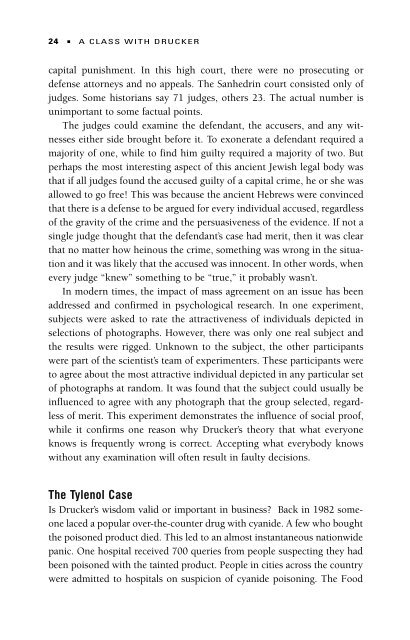A Class with Drucker - Headway | Work on yourself
A Class with Drucker - Headway | Work on yourself
A Class with Drucker - Headway | Work on yourself
Create successful ePaper yourself
Turn your PDF publications into a flip-book with our unique Google optimized e-Paper software.
24 ■ A CLASS WITH DRUCKER<br />
capital punishment. In this high court, there were no prosecuting or<br />
defense attorneys and no appeals. The Sanhedrin court c<strong>on</strong>sisted <strong>on</strong>ly of<br />
judges. Some historians say 71 judges, others 23. The actual number is<br />
unimportant to some factual points.<br />
The judges could examine the defendant, the accusers, and any witnesses<br />
either side brought before it. To ex<strong>on</strong>erate a defendant required a<br />
majority of <strong>on</strong>e, while to find him guilty required a majority of two. But<br />
perhaps the most interesting aspect of this ancient Jewish legal body was<br />
that if all judges found the accused guilty of a capital crime, he or she was<br />
allowed to go free! This was because the ancient Hebrews were c<strong>on</strong>vinced<br />
that there is a defense to be argued for every individual accused, regardless<br />
of the gravity of the crime and the persuasiveness of the evidence. If not a<br />
single judge thought that the defendant’s case had merit, then it was clear<br />
that no matter how heinous the crime, something was wr<strong>on</strong>g in the situati<strong>on</strong><br />
and it was likely that the accused was innocent. In other words, when<br />
every judge “knew” something to be “true,” it probably wasn’t.<br />
In modern times, the impact of mass agreement <strong>on</strong> an issue has been<br />
addressed and c<strong>on</strong>firmed in psychological research. In <strong>on</strong>e experiment,<br />
subjects were asked to rate the attractiveness of individuals depicted in<br />
selecti<strong>on</strong>s of photographs. However, there was <strong>on</strong>ly <strong>on</strong>e real subject and<br />
the results were rigged. Unknown to the subject, the other participants<br />
were part of the scientist’s team of experimenters. These participants were<br />
to agree about the most attractive individual depicted in any particular set<br />
of photographs at random. It was found that the subject could usually be<br />
influenced to agree <str<strong>on</strong>g>with</str<strong>on</strong>g> any photograph that the group selected, regardless<br />
of merit. This experiment dem<strong>on</strong>strates the influence of social proof,<br />
while it c<strong>on</strong>firms <strong>on</strong>e reas<strong>on</strong> why <str<strong>on</strong>g>Drucker</str<strong>on</strong>g>’s theory that what every<strong>on</strong>e<br />
knows is frequently wr<strong>on</strong>g is correct. Accepting what everybody knows<br />
<str<strong>on</strong>g>with</str<strong>on</strong>g>out any examinati<strong>on</strong> will often result in faulty decisi<strong>on</strong>s.<br />
The Tylenol Case<br />
Is <str<strong>on</strong>g>Drucker</str<strong>on</strong>g>’s wisdom valid or important in business? Back in 1982 some<strong>on</strong>e<br />
laced a popular over-the-counter drug <str<strong>on</strong>g>with</str<strong>on</strong>g> cyanide. A few who bought<br />
the pois<strong>on</strong>ed product died. This led to an almost instantaneous nati<strong>on</strong>wide<br />
panic. One hospital received 700 queries from people suspecting they had<br />
been pois<strong>on</strong>ed <str<strong>on</strong>g>with</str<strong>on</strong>g> the tainted product. People in cities across the country<br />
were admitted to hospitals <strong>on</strong> suspici<strong>on</strong> of cyanide pois<strong>on</strong>ing. The Food


